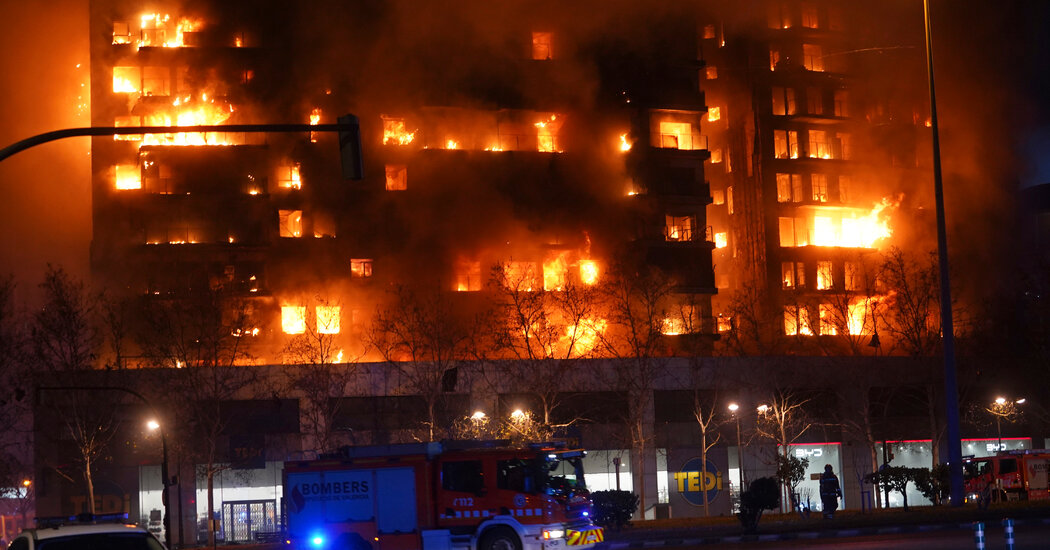A day after a fire roared through a high-rise apartment complex in the Spanish city of Valencia, killing at least 10 people, police investigators were trying to determine why the flames had engulfed the two buildings in less than an hour.
Early suspicion fell on construction materials, but it was hard to tell, since the two structures remained so hot that firefighters could not even enter the buildings until around noon on Friday — hours after rushing to the scene the previous evening.
Luis Sendra, the dean of the Official College of Architects of the Community of Valencia, said that investigators would have to wait until the structures cooled down to be able to determine whether exterior cladding might have helped fuel the fire. He said that gaps between the insulation and the cladding could have facilitated the spread of flames.
“It’s too early to know the exact cause,” Mr. Sendra said. “But the speed with which it spread would indicate similarities with Grenfell Tower in London.”
Seventy-two people were killed in the Grenfell blaze, which consumed a high-rise apartment building in western London in 2017. Flammable materials had been used in the cladding of that building, which accelerated the spread of the fire.
Speaking at a news conference on Friday morning, Carlos Mazón, the president of the regional government, announced a three-day period of mourning and said that seven firefighters had been injured in the blaze.
El País newspaper quoted a regional official, Pilar Bernabé, saying that the death toll stood at 10.
Dramatic footage in the Spanish news media showed one firefighter jumping from the seventh floor to a safety mat on the ground below. Two residents were also rescued from a balcony after becoming trapped by fire: As firefighters held back the flames with fire hoses, the residents scrambled from balcony to balcony to reach a rescue platform lifted up by a fire truck.
The complex in Valencia, Spain’s third-largest city, was made up of a 14-story building and a shorter building, with a total of 138 apartments, according to Mr. Sendra.
A team of 15 forensic officers from the national police are carrying out an investigation into the blaze. The origin of the fire was also unclear.
It was not yet clear what materials were used on the outside of the buildings. Mr. Sendra told the Spanish news media that the use of aluminum on building facades was allowed under Spain’s building regulations, but that the use of polyurethane as insulation was not permitted.
It was not clear whether polyurethane was used. But Esther Puchades, the vice president of the College of Industrial Technical Engineers of Valencia, said in a statement that “all the evidence points at polyurethane as the cause of the voracity of the flames and the color of the smoke.”
A press statement from the college noted that some of the materials on the buildings’ facade had contained plastic that quickly caught fire, but said, “We cannot be sure of the exact material until the investigation is over.”
Pep Benlloch, the president of the local neighborhood association, said in an interview on Antenna 3 television that many foreigners, including Ukrainians, lived in the complex, but that it had originally been empty for a long time because of the prohibitive prices that had been pushed up by a construction boom.
The police and the City Council said they were not able to immediately confirm how many of the apartments were inhabited at the time of the blaze. The complex was built during the boom in the mid-2000s, according to Mr. Sendra.
A 67-year-old resident who gave only his first name, Pep, told the Spanish news media on Friday that he had fled his apartment with his wife shortly after the fire broke out.
“I grabbed my wallet and cellphone, and managed to get out of the inferno,” he said, speaking outside the hotel where he has been temporarily housed.
Jorge, who lives in the neighborhood of Campanar, said he was out on a walk when he saw the blaze, joining a small crowd watching in horror as the building was consumed by flames.
He immediately started filming, capturing video that he posted on social media of the building ablaze, with the sound of screams in the background.
“It was a smell of plastic burning,” Jorge, who gave only his first name, said in an interview. “The smell continues today.”
“I wanted to make the tragedy public,” he added, “so that the authorities take measures in both public and private buildings.”
Valencia’s municipal government said in a statement that a relief point had been set up in a nearby building to offer practical and psychological support to surviving residents.
Prime Minister Pedro Sánchez visited the scene of the fire on Friday, thanking emergency workers and offering his “solidarity and affection” to families affected by the fire.
“The priority now is the search for victims,” he said.
Emily Schmall contributed reporting.

